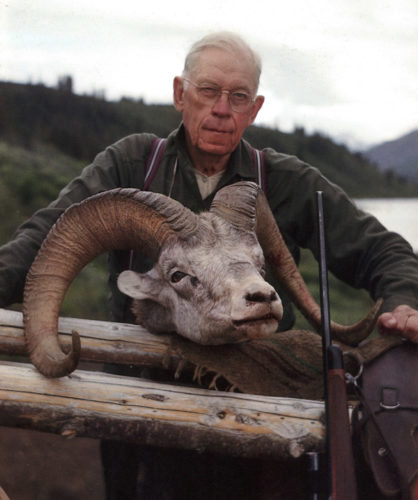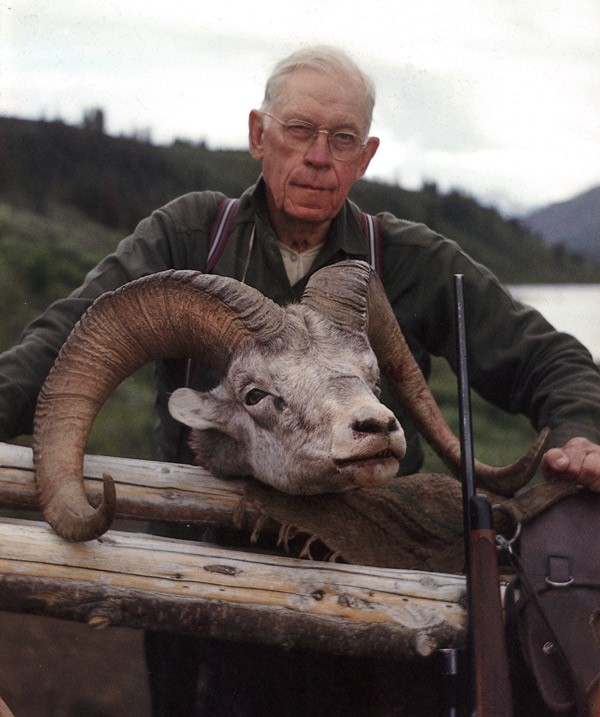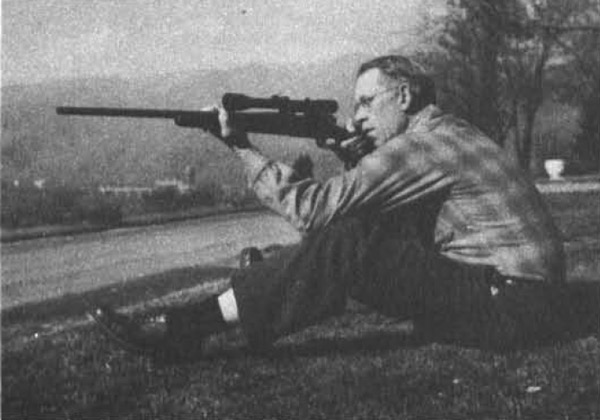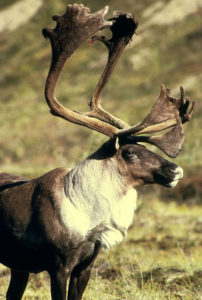

Editor's Note: Jack O’Connor was one of the most prolific figures in American gun writing. The longtime firearms editor for Outdoor Life magazine introduced a great swath of America to hunting and firearms through countless books and articles.
O’Connor’s unique life was the driving force in the development of his technical background and always enlightening perspective on firearms and hunting. Born January 22, 1902 in the Arizona Territory, he was witness to the closing of the old West. As an adult, he hunted all over the world, collecting trophies from nearly every continent. And throughout his life he was a refined man of letters, serving as an English professor at the University of Arizona and becoming the school’s first journalism professor.
O’Connor is perhaps best known for his passion, sheep hunting. As pointed out at the Jack O’Connor Hunting Heritage and Education Center’s website, “by 1946 he collected three or more of each of the four wild sheep species in North America, becoming the fourth and fifth man to complete such a collection.”
O’Connor also graced the pages of the Gun Digest Annual for many years. What follows is an excerpt from one of his earliest contributions, an article titled Tips on Big Game Shooting from the 1952 edition of the annual. As always, O’Connor's writing leaves his readers entertained, but more importantly educated.
Hold ‘em, squeeze ‘em, and call ‘em!
This is the formula for becoming a good big game shot, just as it is for becoming a good shot of any kind.
The man interested primarily in being a game shot should practice largely in the position he will use in the field, and as much as possible under the conditions he will encounter in the field. Of the standard positions, the two most useful are sitting and offhand. Since I have done most of my big game hunting in the mountains and canyons of western North America, I have shot probably 70 percent of the big game I have killed from the sitting position – and that includes running game. I have shot some big game from the kneeling position, but I’d make a guess that of the other 30 percent, about half was shot from offhand and the other half from prone.
Sitting is the queen of hunting positions, particularly in the mountains. It brings the muzzle of the rifle high enough to clear grass and low shrubs. It can be used from a hillside. It is much steadier than offhand or kneeling. It is somewhat less steady than prone, but it is far more flexible and adaptable. Practice in the sitting position pays big dividends. It is a far better position for general use than kneeling.

Offhand is the most useful position for the woods hunter, be those woods in Pennsylvania or India, and no one can call himself a good all-around shot unless he is fairly deadly in that position. It is the position for short-range shooting at running game and the most flexible (if also the most unsteady) of all positions.
A cardinal rule of big game shooting is to use the steadiest position it is possible to assume in order to make the first shot as nearly exactly right as possible. No one should ever take an offhand shot if he can sit, or a standing shot if he can get prone. In a book I read by an Englishman who was for years an African guide and professional hunter, the author wrote that he always sat down when he shot to stop the charge of an enraged lion, rhino, or Cape buffalo. One shot in the right place is worth a dozen poorly placed shots.
The big game hunter should never be too proud to use a rest if he has the time and has no choice but to make a difficult shot. He should pad a hard surface with a jacket, a hat, or his hand, and he should rest the rifle on the fore-end so that the shot will not fly high. In hunting antelope in open plains, my favorite stunt is to wad up a jacket and rest it over a clump of sagebrush and then rest the rifle on it. Shooting that way I have killed several antelope at ranges paced, not guessed, at from 300 to, in one case, a bit short of 500 yards. Because of the fairly level terrain in which they are usually found, antelope can – in the majority of cases – be shot from prone or prone with rest. Again, let me repeat that any hunter is a sucker who does not make the most of his opportunity by using the steadiest position he can assume.
I have seen many hunters stand on their hind legs and blaze away at running antelope 300 yards and more away and shoot offhand at standing deer across a canyon when in each case they could have planted their posteriors firmly on mother earth with much better chances of a hit.
I have shot two bull moose offhand, one of which was running; and two from the sitting position, one of which was running. The longest shot I have ever taken at a moose was at about 200 yards. Of the mountain sheep I have shot, two were shot offhand at very short range, two at long range from a padded rest, two from prone, the others from the sitting position. Because, like antelope, the caribou is an open country animal, I have shot more caribou from prone than from any other position. Deer I have shot in brush country were almost all taken offhand, those in the mountains from the sit.
In big game shooting then, the steadiest possible position should be used so that the first shot will be in the vital area. This shot should also be taken as quickly as possible and the shot should always be called. In other words, the hunter should know exactly where his sights rested when his rifle went off. He must know it, because if he does not he cannot hold-over for a long shot or his lead for a running shot. In practice, he should get off his shots the instant the sights look right. He should form the habit of shooting at once instead of dawdling because in the game fields, his quarry may turn into a less favorable position or may move off.

Shoot from the steadiest position you can get into. Place the shot right. Call the shot. Shoot quickly.
I missed the only double-shovel caribou I ever got a shot at by fooling around. The caribou was standing, and around 300 yards away. I got into a prone position. I thought I had all the time in the world, so instead of shooting immediately, I squeezed one off on an empty chamber, just to see how I was holding that day. The crosshairs were just right, and if there had been a cartridge in the chamber that would have been a dead caribou. As I started to work the bolt, that doggoned caribou took two steps and dropped over the edge of a ravine. When I next saw him he was a mile away trotting like a race horse. We had the wind on him and he gave no evidence of having seen us. Maybe he had forgot to mail a letter.

Next Step: Get your FREE Printable Target Pack
Enhance your shooting precision with our 62 MOA Targets, perfect for rifles and handguns. Crafted in collaboration with Storm Tactical for accuracy and versatility.
Subscribe to the Gun Digest email newsletter and get your downloadable target pack sent straight to your inbox. Stay updated with the latest firearms info in the industry.








No, they don’t have gun writers like O’Connor anymore. He was actually an honest gun writer. He made no bones about the post-64 Winchester, he thought it was a piece of trash, you would never get that kind of an editorial from todays gun writers. In his book “Confessions of a Gun Writer” he exposed Elmer Keith for the liar and buffoon that he was. His advice on using smaller and non-magnum calibers flew in the face of the “Big Bore Magnum lunatics” because O’Connor had something they never had and that was actual hunting experience.
O’Connor was a “real hunter” often stalking mountain sheep within 25 yards. None of this modern “slob shooting” from non-sporting long distances that only results in wounded animals or worse yet from helicopters, now that one really gives hunters a bad name.
O’Connor’s writing made you feel that you were with him every step of the way and he often told you interesting personal stories. Compare this to todays gun writer trash writing that is done only to sell the “latest and greatest” plasticky, stamped sheet metal and cast iron garbage the firearms industry is vomiting out today.
And lets not forget some of his contemporaries like Warren Page, Nash Buckingham, Townsend Whelen, Ted Trueblood, Robert Ruark, Charles Askins Sr. and Jr., Frank Dufrense, Jim Rearden, Bill Jordan, and Cory Ford just to name a few.
Today we have none of the likes of above, only people who write paid advertisements for the gun industry. I doubt if any of them ever hunted in their entire lives and their writing sure shows it when the often make ridiculous statements like Brian Towsley when he stated the .270 was just barely adequate for deer, brother that one made us howl in the aisles, because we then knew he never hunted with the caliber in his entire life.